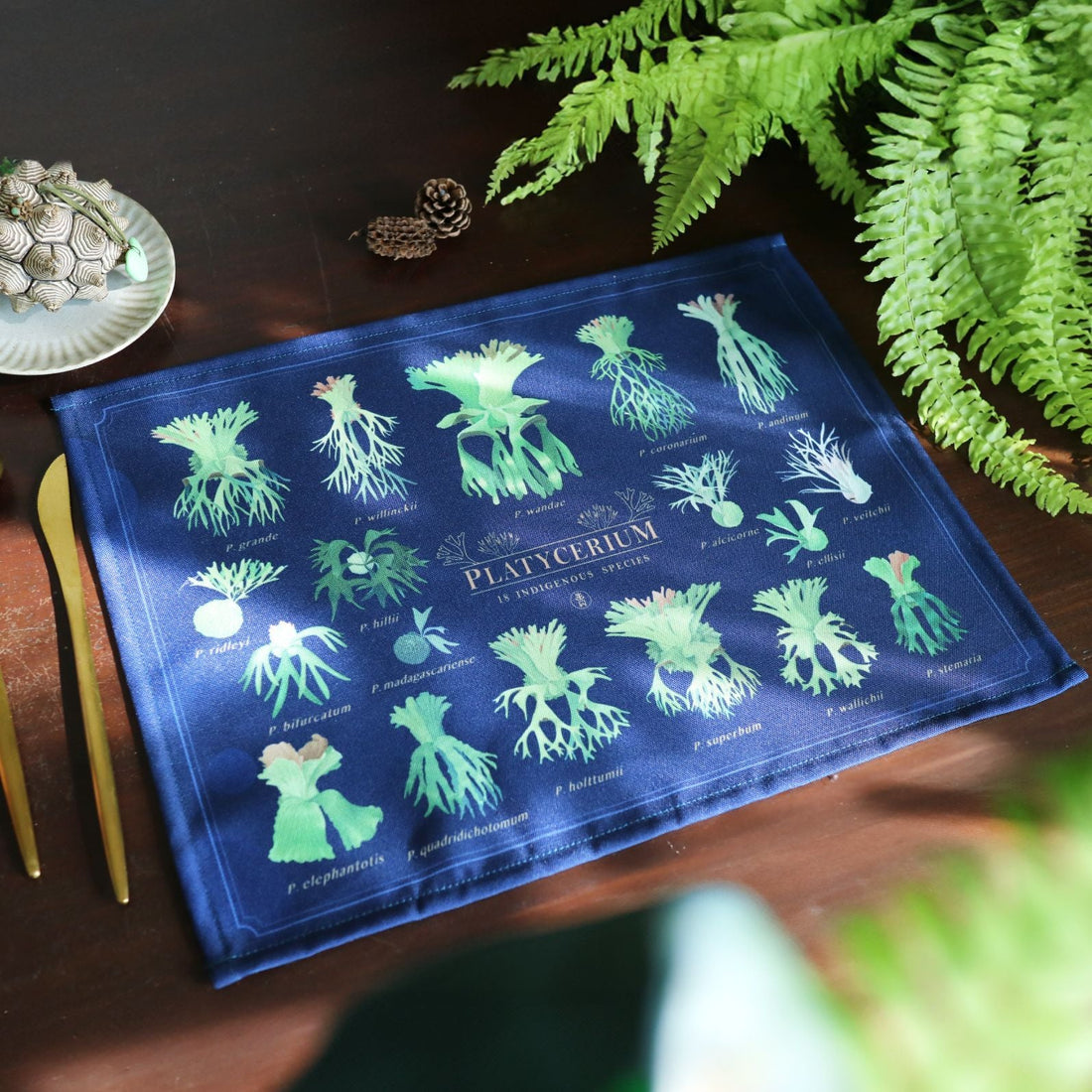
Your Guide to Choosing a Staghorn
Staghorn ferns arrest the eye like frozen waterfalls of green, their antler-like fronds defying gravity and convention. These epiphytic sculptures transform spaces into living galleries, each species offering its own aesthetic proposition. The heart wants what it wants, and in the world of Platycerium, this becomes your greatest guide.
Here lies the beautiful truth: while their forms vary wildly—from classic bifurcated fronds to intricate brain-like patterns—their fundamental care remains remarkably consistent. Bright, indirect light. Consistent moisture without waterlogging. High humidity. This consistency liberates you to choose purely on visual attraction, knowing that success requires gentle adjustments, not entirely different approaches.
The staghorn enthusiast possesses impeccable taste by nature. These aren't plants for the ordinary-seeking. They're living sculptures that blur the line between horticulture and art, conversation pieces that demand attention and reward it with ever-changing displays of natural architecture.
The Architectural Archetype: Bold Statements
Platycerium superbum commands rather than occupies space. True to its "superb" designation, this species represents staghorn architecture at its most ambitious. Shield fronds grow into broad, dramatic fans spanning three feet, creating sculptural foundations that suggest both ancient pottery and contemporary art. The fertile fronds emerge as undulating sheets dividing into multiple lobes, cascading six feet in frozen waterfalls of green.
This solitary giant develops unique personality over time, each specimen becoming one-of-a-kind sculpture. Its seasonal rhythm adds theatrical appeal—new shields emerge as bright green contrasts to established brown bases, while fertile fronds unfurl like enormous scrolls revealing their contents gradually.
Platycerium wandae elevates this archetype to royal status. The largest staghorn species, thirty percent larger than superbum, carries itself with dignity befitting its "Queen" designation. Shield fronds span six feet, growing remarkably upright into basket-like structures crowned with distinctive frills. Fertile fronds display unique two-lobe structure—one small and elevated, one large and hanging—creating asymmetrical yet perfectly balanced compositions reaching six feet in graceful cascades.
Both species function as living focal points, statement pieces that change entire room characters. They reward patience with increasingly dramatic displays, living sculptures that continue evolving throughout their long lives.
The Ethereal Archetype: Silvery Luminescence
Platycerium veitchii captures moonlight and holds it in its fronds. This ethereal beauty challenges preconceptions with its extraordinary silvery coating—dense microscopic hairs creating almost metallic sheen that makes fronds shimmer and dance in light. Shield fronds develop upward-growing finger-like projections, adding sculptural vertical elements. Fertile fronds maintain architectural stance before extending outward, creating unique sculptural quality.
This silvery armor reflects excess light while retaining moisture, making veitchii one of few staghorns tolerating direct sun. The adaptation opens placement possibilities unavailable to other species, often producing even more pronounced coloration in response to higher light.
The plant functions as living accent piece, catching and reflecting available light while brightening spaces. Its deliberate growth pace means each frond emerges perfectly formed, the plant seemingly taking pride in its own appearance.
The Intricate Archetype: Natural Artistry
Platycerium ridleyi stands apart as perhaps the most architecturally complex staghorn. The "Asian Monkey Brain" challenges every assumption about staghorn appearance, presenting forms so unique they seem to belong to different plant families entirely.
Shield fronds develop into intricate, deeply lobed formations immediately suggesting the common name. Raised veining creates patterns reminiscent of brain coral or alien landscapes. As plants mature, shields curve inward, eventually forming spherical structures completely encasing growing points—natural sculptures from which fertile fronds emerge.
Fertile fronds appear as narrow, upright structures dividing into finger-like projections, creating fountain-like displays both elegant and dramatic. Each plant develops unique character, making every specimen truly one-of-a-kind natural sculpture.
This species rewards close examination, revealing new details with each viewing. Its measured growth creates anticipation as new structures emerge and develop, like observing natural sculpture slowly revealing final form.
The Contemporary Archetype: Concentrated Perfection
Platycerium willinckii 'Jenny' represents the intersection of natural mutation and human cultivation. This remarkable dwarf concentrates willinckii beauty into manageable, intensely detailed form. Shield fronds display characteristic fan shape with distinctive metallic sheen, while fertile fronds emerge as narrow, highly divided formations cascading in graceful, pendulous displays.
The level of division creates intricate, lace-like patterns seeming almost too delicate for reality. Frond ends develop distinctive curling patterns resembling tiny fists, adding whimsical quality to sophisticated appearance. This combination of intricate division and playful curling creates visual texture unique among staghorns.
'Jenny's' compact size makes every detail easily visible, turning each specimen into living botanical art fully appreciable from close range. However, this beauty demands careful attention—the genetic mutation creating dwarf characteristics also increases environmental sensitivity.
The Curly Archetype: Whimsical Grace
Platycerium 'FSQ' (Foong Siqi) embodies whimsical elegance through its signature 360-degree curling fertile frond tips. Known as "捲捲鹿" (Curly Staghorn), this cultivar transforms the typical staghorn silhouette into something resembling elaborate green spirals or botanical corkscrews. The fertile fronds cascade gracefully downward before their tips curl inward in perfect spirals, creating a waterfall effect crowned with natural ringlets.
This distinctive curling occurs as the plant reaches sexual maturity, typically after 1-2 years, when spore production causes the frond tips to curl dramatically. The effect resembles having a head of curly hair, with each fertile frond ending in its own perfect spiral. Shield fronds display the characteristic white-fuzzy coating with clear veining, while mature plants can reach 60-100cm in diameter.
Originally created by Malaysian breeder SS Foong and named after his daughter, FSQ has become the parent of numerous other cultivars including the famous tissue-cultured varieties. Its high genetic variability makes it a "cradle" for producing exceptional offspring, while its relatively forgiving nature makes it accessible to intermediate growers seeking something beyond the ordinary.
The Classic Foundation: Reliable Beauty
Platycerium bifurcatum provides the perfect introduction to staghorn aesthetics without overwhelming newcomers. This ambassador species offers classic forked fertile fronds covered in silver-green felt that shifts color with light. Its natural tendency to form colonies through offsets creates living wall sculptures over time, while its forgiving nature teaches essential staghorn rhythms.
At two to three feet, it commands attention without overwhelming spaces, making it ideal for those beginning their staghorn journey or seeking reliable beauty without specialized care demands.
Legendary Specimens: The Cutting Edge
Platycerium 'Rydeen' embodies explosive energy suggested by its lightning name. This hybrid combines veitchii silvery upright crown with Mt. Lewis blue-green coloration and fine divisions. Shield fronds develop "wild crown" formation creating dramatic silhouette resembling botanical lightning strike—wild yet controlled, natural yet architectural.
Platycerium bifurcatum 'SP White' intensifies silvery characteristics in classic, approachable form. Enhanced coating makes fronds shimmer like frosted antlers while maintaining bifurcatum's forgiving nature.
Platycerium veitchii 'Auburn River' represents the species at its most refined—even more pronounced upright growth and dazzling, almost iridescent white sheen surpassing typical specimens.
Platycerium willinckii 'Yellow Moon Dwarf' offers unique color variation with delicate, highly dissected fronds unfurling in soft, golden hue, creating compact, intricate starburst of warm-toned foliage.
The Path Forward
These specimens represent glimpses into incredible diversity and ongoing evolution of the staghorn world. Each tells stories of dedicated cultivation, careful selection, or fortunate discovery, showing how natural beauty and human passion continue producing plants exceeding expectations.
The beauty of aesthetic-focused selection opens doors to discoveries you might never imagine. That plant stopping you in your tracks, making your heart race with possibility, might be architectural superbum, ethereal veitchii, or whimsical FSQ. The important thing is the connection you feel, the recognition that this particular plant speaks to your aesthetic sense transcending practical considerations.
Your perfect botanical companion awaits. Trust your aesthetic instincts, embrace the discovery journey, and prepare for amazement at the incredible diversity these remarkable plants offer. In choosing a staghorn fern, you're not selecting a plant—you're choosing living art that will continue evolving, surprising, and inspiring for years to come.
Let your eye guide you, explore the stunning forms nature and cultivation have created, and discover the staghorn fern that truly speaks to your heart.
